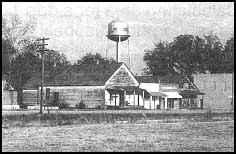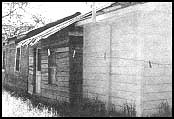|
Failing septic systems
Norwood's drip soil absorption system, together with associated gravity sewer collection system and treatment and storage ponds, was constructed as a replacement for failing septic systems, according to Mayor David L. Harper.
He says the septic system problem first became apparent in the late 1970s and early 1980s when several community wells were contaminated by faulty septic systems.
Over the years, septic tank drainfields had become saturated and septic tank effluent surfaced, ultimately ending up in the area's waterways. At one point the community initiated a search for funding for a new wastewater system, but came up empty-handed. The problem reached crisis proportions in 1990, when the Warren County Health Department condemned all of Norwood's onsite systems, maintaining that even those onsite systems that were properly installed presented potential health hazards.
Financing and planning
With no alternative but to come up with the funding that had earlier been denied them, the tiny community rallied around the cause. "Everyone realized what kind of shape we were in," says Harper. "It was clear we had a health problem."
The mayor and six-member town council next set about conducting public hearings and searching for funding. Because most of Norwood's citizens are in the low-to-moderate income range, Harper points out that obtaining outside funding was crucial to the project's success. To assist them in this task, the town called on the services of Precision Planning, Inc., of Lawrenceville, Georgia, a firm with experience in assisting small communities in developing financing for public works.
Armed with a letter from local health officials explaining Norwood's desperate situation, the community applied for federal funding from the Farmers Home Administration (FmHA) and was successful in obtaining a $231,400 loan and a $627,797 grant.
Norwood also received a $400,000 Community Development Block Grant (CDBG) from Georgia's Department of Community Affairs. According to Harper, this grant funded the installation of bathrooms for four homes and also helped make Norwood's FmHA loan repayments more manageable.
In addition to federal and state funding, Norwood itself provided $17,000 toward the system, most of which was used to cover the "tap in" fee required to connect the sewer service to individual homes, a move that helped ease the financial burden on individual residents.
Choice of technology
Norwood's next task was to obtain a permit from the Environmental Protection Division (EPD) of the Georgia Department of Natural Resources, the agency responsible for permitting Georgia's municipal wastewater treatment systems. The community applied for, and was denied, a direct discharge permit.
Such a denial is a common occurrence in Georgia, according to Ernest Earn, technology transfer coordinator for the Georgia EPD. He explains that the state's rules aggressively require land application methods (drip or spray) because they present the least threat to receiving streams. "We think it is a better way of protecting our resources," he explains.
Earn points out that Georgia is currently developing design guidelines for drip irrigation systems that are due to be published soon.
Norwood initially considered using a spray irrigation system to land apply its effluent, but the relatively large amount of land it required posed problems for the tiny community, which had managed to acquire only a 20-acre tract outside town to house its entire treatment facility.
Because the treatment of the effluent occurs underground in a drip irrigation system, it requires less separation distance (buffer zone) between it and adjoining land. (In Georgia, the minimum buffer required between a spray system and adjacent land is 150 feet, but only 25 feet for a drip system.)
The project's engineering design firm, Precision Planning, Inc., began developing the drip irrigation concept for the Norwood site with assistance from Waste Water Systems, Inc., a local manufacturer of drip disposal systems.
Patsy Allen, senior vice president of Precision Planning, says one consideration for selecting the drip system was that the spray system required a greater amount of operation and maintenance (O & M). She says this would have required a full-time operator, an expense that would have been too great for a town as small as Norwood.
Septic tanks were not considered because the high water table in the area could create problems, says Ward.
The mayor and town council toured several drip disposal sites. Harper says they were most impressed with what they could not see - or smell. Because everything happens underground, he explains, there was absolutely no odor and the drip disposal field itself looked like any other grass-covered field.
Much impressed, the city council voted unanimously to use the new drip soil absorption technology. The new system's design was completed in June 1991, and the project began construction in November 1991. The system was officially dedicated on November 13, 1992.
New system
Harper says the new system "really cleaned up the town." He explains that an added advantage is that there is room for expansion. The new facility, which is currently operating at about 25,000 gallons per day (gpd) is claimed to be actually capable of handling 50,000 gpd. It is hoped that this feature will eventually help attract industry to the area, Harper explains.
The completed system serves 125 users in its service area. Effluent collected in Norwood's gravity sewers first enters two aerated ponds where it is treated and stored prior to entering the drip system.
Aerators in the first pond provide oxygen and begin the treatment process. A second pond is primarily intended for sedimentation and storage. It holds 400,000 gallons - enough to store up to eight days of the system's design flow. This allows the system to cease operations during the mechanical or power failures and in wet weather.
From there, irrigation pumps move the treated wastewater from the storage pond to a series of three subsurface irrigation fields, where it is delivered at a rate of 125 gallons per minute.
The drip field consists of three separate drip fields, side by side, that are used on a rotating basis (known as "alternative dosing.") Together they cover five acres. Polyethylene distribution lines or "dripper lines " installed underground distribute approximately 17,500 gpd of wastewater per field.
The system also is outfitted with a computer control system. This system downloads and keeps records of statistics, records flow, and monitors critical functions. Alarms sound when there is a problem such as low water, high water level in the dosing tank, or a flow rate greater than the design flow, according to Sinclair.
He points out that the computer monitoring is a preventative measure that spots potential problems that would be costly to correct if they went undetected. He emphasizes that it usually means a smaller O & M bill and also relieves the community of the responsibility, and added expense, of employing a full-time operator. (Norwood employs only one part-time operator.)
Costs
Total construction cost for Norwood's system was $950,190, almost 59% of which was for the gravity sewer collection system. The treatment pond accounted for another 25% of the total, and the disposal system accounted for 16%.
O & M was projected to be $1,500 to $2,000 per month. However, actual O & M costs have been well below that. For example, the actual cost for a two-month period in 1993 was only $1,360 per month, of which $360 was for power, $200 was for sample testing, and $800 was for labor.
Norwood's costs for its new system include a $1,325 per month payment toward its 40-year loan. The average monthly bill for Norwood residents, which includes both water and sewer, is approximately $28 to $29.
The Norwood facility is equipped with groundwater observation wells that allow the city to monitor groundwater quality twice a year. To fulfill conditions of the Georgia EPD Land Application System Permit, its effluent is tested for 13 different chemical and physical parameters. Preliminary data on groundwater analysis indicates a nitrate concentration of less than one milligram per liter.
The future
Georgia EPD's Earn says he sees many beneficial uses for the drip soil absorption system down the road. He says drip systems have many advantages for municipalities, one of which is that they are less labor intensive than a spray system.
In addition, he explains that they are ideal for use in parks, in greenbelts, and roughs along golf courses. He says the EPD has found them to be "very forgiving systems."
Meanwhile, Sinclair says he feels that the systems have turned a corner with regard to acceptance by the regulatory community and the method is starting to catch on. "We are daily getting calls from all over the country," he says.
He points out that, among other projects, his company is currently working with Precision Planning on a one-million gallon municipal system for another Georgia community, which may begin construction by fall.
| 


